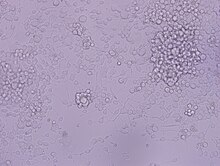User:Jammin1993/draft proposal
| This article was the subject of an educational assignment. |
This topic is being edited as an assignment in an undergraduate neurobiology course. The course is participating in the Wikipedia Education Program. The revised article will be posted by March 24, 2014.
PC12 is a cell line derived from a pheochromocytoma of the rat adrenal medulla, that have an embryonic origin from the neural crest that has a mixture of neuroblastic cells and eosinophilic cells.[1][2][3] With their embryological origin with neuroblastic cells they can easily differentiate into neuron-like cells even though they are not considered neurons in an adult. PC12 cells stop dividing and terminally differentiate when treated with nerve growth factor or dexamethasone.[4] This makes PC12 cells useful as a model system for neuronal differentiation and neurosecretion. It was developed in parallel to the adrenal chromaffin cell model because of its extreme versatility for pharmacological manipulation, ease of culture, and the large amount of information on their proliferation and differentiation.[5] These qualities provide advantage even though they have smaller vesicles and quantal size, holding only an average of 190 zeptomoles released.[5] The vesicles hold catecholamines, mostly dopamine but also limited amount of norepinephrine, and release of these neurotransmitters give rise to amperometric spikes similar to chromaffin cells.
PC12 cell line use has given much information to the function of proteins underlying vesicle fusion. Used to understand the job of synaptotagmin in vesicle fusion, in which increase in calcium concentration displaces synaptotagmin and catalyzes membrane fusion.
Differentiation of PC12 cells[edit]
Treatment of PC12 cells with nerve growth factor creates cells with long processes or neurite varicosities, which contain small amounts of vesicles. PC12 cells treated for 10-14 days with nerve growth factor had no release of vesicles from the cell body which indicates the aggregation of vesicles in the ends of the neurites. [5]
Treatment of PC12 cells with dexamethasone differentiates them into chromaffin-like cells. Using patch clamp recording and amperometry there was a significant increase in quantal size, excitability and coupling between calcium channels and vesicle release sites, increasing from ~200 to ~650 zeptomoles.[5]
Drugs Effects on Vesicles of PC12 Cells[edit]
Research has shown differences in vesicle size and quantal size depending on treatment with certain drugs. L-DOPA has shown increase in average quantal size when treated for only 40-90 minutes.[5] Treatment with amphetamine or reserpine causes a reduction in vesicle content.[5] Inserting the heavy metals Lead(II), Cadmium(II), Strontium(II), or Barium(II) have been shown to have agonist to the calcium-sensor synaptotagmin.[5] Other organics have been studied using this cell line to understand their effects on PC12 cells These types of studies show that use of PC12 cell line can be a model for past and future neurotoxicological studies.
Disease Research[edit]
The PC12 cell line has been used to get more information about diseases of the brain. It has been used in research of hypoxia, where acute hypoxia induces exocytosis and prolonged hypoxia can induce excessive exocytosis. PC12 cells were used to find which prion protein fragments caused neuronal dysfunction.[5] PC12 was used partly for some forms of Parkinson’s disease with finds that support interference after vesicle docking and prior to vesicle release.

See also[edit]
References[edit]
- ^ Greene LA, Tischler AS (July 1976). "Establishment of a noradrenergic clonal line of rat adrenal pheochromocytoma cells which respond to nerve growth factor". Proc. Natl. Acad. Sci. U.S.A. 73 (7): 2424–8. doi:10.1073/pnas.73.7.2424. PMC 430592. PMID 1065897.
- ^ "PC-12/CRL-1721 cell line". LGC Promochem: Cell Biology Collection. American Type Culture Collection. Retrieved 2008-08-15.
{{cite web}}: Cite has empty unknown parameter:|coauthors=(help) [dead link] - ^ "Adrenal Gland and Paraganglia - Embryology".
- ^ Center for Cancer Education
- ^ a b c d e f g h R.H.S. Westerink and A.G. Ewing. The PC12 cell as model for neurosecretion. Acta Physiol(Oxf), 2008 February, 192(2): p. 273-285. doi:10.1111/j. 1784.2007.01805.x.
External links[edit]
- Wikipedia articles containing the term "PC12 cells" [1]
- table of common cell lines including PC12 [2], from Alberts 4th edition at NCBI bookshelf
- Ras function was partially elucidated using PC12 cell line [3], from section in Cancer Medicine textbook
- Section on neural transmission [4] has several references to PC12 cell line
